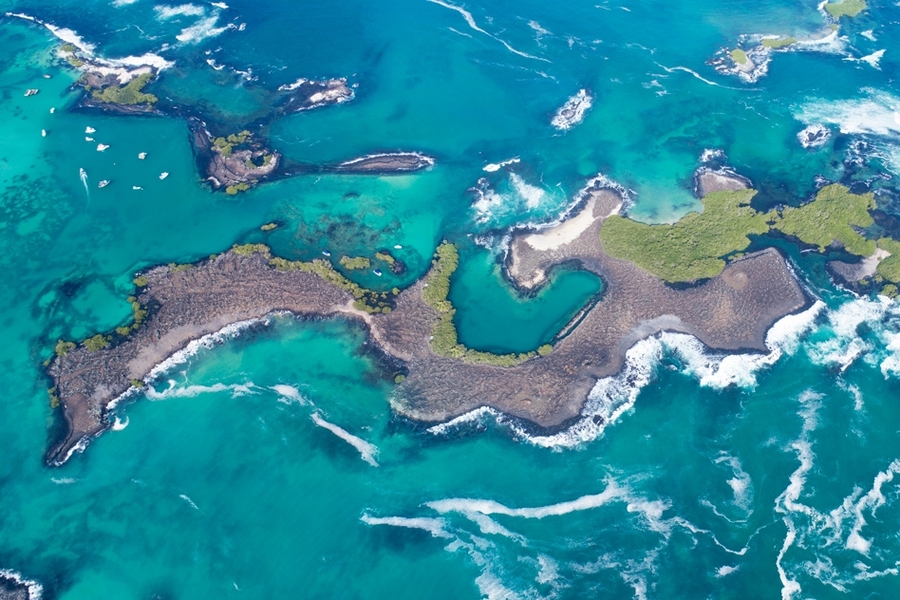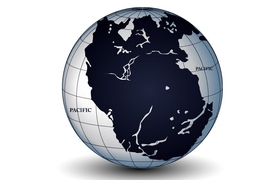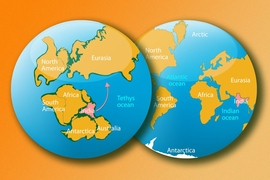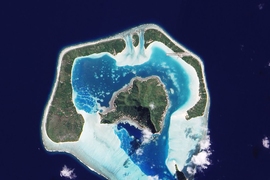When a hot plume of rock rises through the Earth’s mantle to puncture the overlying crust, it can create not only a volcanic ocean island, but also a swell in the ocean floor hundreds to thousands of kilometers long. Over time the island is carried away by the underlying tectonic plate, and the plume pops out another island in its place. Over millions of years, this geological hotspot can produce a chain of trailing islands, on which life may flourish temporarily before the islands sink, one by one, back into the sea.
The Earth is pocked with dozens of hotspots, including those that produced the island chains of Hawaii and the Galapagos. While the process by which volcanic islands form is similar from chain to chain, the time that any island spends above sea level can vary widely, from a few million years in the case of the Galapagos to over 20 million for the Canary Islands. An island’s age can determine the life and landscapes that evolve there. And yet the mechanisms that set an island’s lifespan are largely unknown.
Now scientists at MIT have an idea about the processes that determine a volcanic island’s age. In a paper published today in Science Advances, they report an analysis of 14 major volcanic island chains around the world. They found that an island’s age is related to two main geological factors: the speed of the underlying plate and the size of the swell generated by the hotspot plume.
For instance, if an island lies on a fast-moving plate, it is likely to have a short lifespan, unless, as is the case with Hawaii, it was also created by a very large plume. The plume that gave rise to the Hawaiian islands is among the largest on Earth, and while the Pacific plate on which Hawaii sits is relatively speedy compared with other oceanic plates, it takes considerable time for the plate to slide over the plume’s expansive swell.
The researchers found that this interplay between tectonic speed and plume size explains why the Hawaiian islands persist above sea level for million years longer than the oldest Galapagos Islands, which also sit on plates that travel at a similar speed but over a much smaller plume. By comparison, the Canary Islands, among the oldest island chains in the world, sit on the slow-moving Atlantic plate and over a relatively large plume.
“These island chains are dynamic, insular laboratories that biologists have long focused on,” says former MIT graduate student Kimberly Huppert, the study’s lead author. “But besides studies on individual chains, there’s not a lot of work that related them to processes of the solid Earth, kilometers below the surface.”
“You can imagine all these organisms living on a sort of treadmill made of islands, like stepping stones, and they’re evolving, diverging, migrating to new islands, and the old islands are drowning,” adds Taylor Perron, associate head of MIT’s Department of Earth, Atmospheric and Planetary Sciences. “What Kim has shown is, there’s a geophysical mechanism that controls how fast this treadmill is moving and how long the island chains go before they drop off the end.”
Huppert and Perron co-authored the study with Leigh Royden, professor of earth, atmospheric and planetary sciences at MIT.
Sinking a blowtorch
The new study is a part of Huppert’s MIT thesis work, in which she looked mainly at the evolution of landscapes on volcanic island chains, the Hawaiian islands in particular. In studying the processes that contribute to island erosion, she dug up a controversy in the literature regarding the processes that cause the seafloor to swell around hotspot islands.
“The idea was, if you heat some of the bottom of the plate, you can make it go up really fast by just thermal uplift, basically like a blowtorch under the plate,” Royden says.
If this idea is correct, then by the same token, cooling of the heated plate should cause the seafloor to subside and islands to eventually sink back into the ocean. But in studying the ages of drowned islands in hotspot chains around the world, Huppert found that islands drown at a faster rate than any natural cooling mechanism could explain.
“So most of this uplift and sinking couldn’t have been from heating and cooling,” Royden says. “It had to be something else.”
Huppert’s observation inspired the group to compare major volcanic island chains in hopes of identifying the mechanisms of island uplift and sinking — which are likely the same processes that set an island’s lifespan, or time above sea level.
Evolution, on a treadmill
In their analysis, the researchers looked at 14 volcanic island chains around the world, including the Hawaiian, Galapagos, and Canary islands. For each island chain, they noted the direction in which the underlying tectonic plate was moving and measured the plate’s average speed relative to the hotspot. They then measured, in the direction of each island chain, the distance between the beginning and the end of the swell, or uplift in the crust, created by the underlying plume. For every island chain, they divided the swell distance by plate velocity to arrive at a number representing the average time a volcanic island should spend atop the plume’s swell — which should determine how long an island remains above sea level before sinking into the ocean.
When the researchers compared their calculations with the actual ages of each island in each of the 14 chains, including islands that had long since sunk below sea level, they found a strong correlation between the time spent atop the swell and the typical amount of time that islands remain above sea level. A volcanic island’s lifespan, they concluded, depends on a combination of the underlying plate’s speed and the size of the plume, or swell that it creates.
Huppert says that the processes that set an island’s age can help scientists better understand biodiversity and how life looks different from one island chain to another.
“If an island spends a long time above sea level, that provides a long time for speciation to play out,” Huppert says. “But if you have an island chain where you have islands that drown at a faster rate, then it will affect the ability of fauna to radiate to neighboring islands, and how these islands are populated.”
The researchers posit that, in some sense, we have the interplay of tectonic speed and plume size to thank for our modern understanding of evolution.
“You’re looking at a process in the solid Earth which is contributing to the fact that the Galapagos is a very fast moving treadmill, with islands moving off very quickly, with not a long time to erode, and this was the system that led to people discovering evolution,” Royden notes. “So in a sense this process really set the stage for humans to figure out what evolution was about, by doing it in this microcosm. If there hadn’t been this process, and the Galapagos hadn’t been on that short residence time, who knows how long it would have taken for people to figure it out.”
This research was supported, in part, by NASA.










